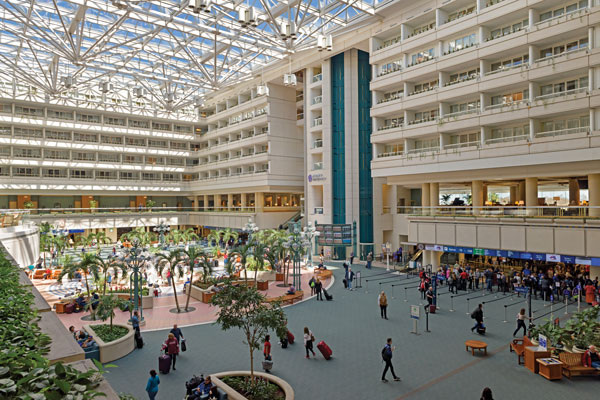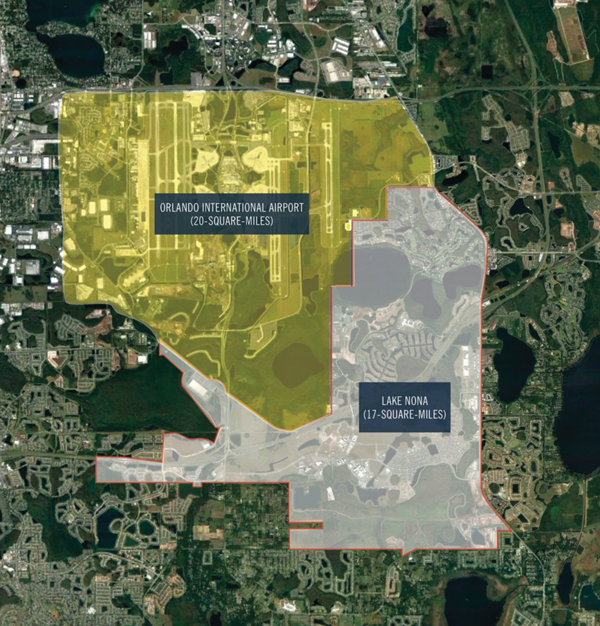Tucked into a 37-square-mile area of southeast Orlando are two contiguous developments shaping the future of America’s most visited city: Orlando International Airport and Lake Nona.
A magnet for 80 million visitors each year, Greater Orlando is not just the king of tourism in the Western Hemisphere. It is also providing the world with a blueprint for the future of transportation infrastructure, economic development, and thriving business and commerce centers.
At the center of this confluence is a place billed as the world’s next great Airport City — where Orlando International Airport (MCO) and Lake Nona come together. How important is this 37-square-mile location? Consider this:
 Orlando International Airport is the busiest in Florida, serving 58 million passengers per year.
Orlando International Airport is the busiest in Florida, serving 58 million passengers per year.
Photos courtesy of GOAA
MCO ranked as the seventh busiest airport in the U.S. last year, welcoming nearly 58 million passengers.
Contiguous to the airport is Lake Nona, one of the fastest-growing communities in the U.S. Lake Nona is a smart city known for its innovation and sustainability. Home to cutting-edge medical and research institutions, it fosters a thriving health, wellness and technology ecosystem that regularly lands new corporate facility projects.
MCO’s new Terminal C expands its capacity to accommodate millions more passengers annually. Led by the Greater Orlando Aviation Authority’s (GOAA) 2023 Strategic Plan, MCO is set to lead in mobility and connectivity.
Kevin J. Thibault, CEO of GOAA, says this is just the beginning. “The past 24 years presented the travel industry with a number of challenging periods. Through it all, GOAA maintained its commitment to providing a world-class travel experience for all passengers at Orlando International Airport,” he says. “GOAA concentrated on keeping the airport community focused and engaged, and it showed in the remarkable resiliency demonstrated in the wake of downturns. MCO traffic has returned robustly since 2000, when 30.8 million passengers traveled through the airport, to nearly 58 million in 2023.”
Thibault says that the Airport City concept is crucial to Orlando’s next phase of growth. “Leveraging a vibrant ecosystem, including aerospace, high-tech companies and educational institutions, will create the potential for an Airport City. This will be a pivotal hub for the region and the state,” he notes.
Rail, eVTOLs Enter the Mix
MCO plans to build on its Airport City hub by adding high-speed rail connectivity and electric vertical takeoff and landing vehicles (eVTOLs). “Our vision is to be the global leader in the evolution of mobility,” says Thibault. “Brightline began intercity rail service in September of 2023 between Orlando International Airport and Miami, with four stops in between, and more Florida routes planned. Multiple trains arrive and depart daily from the Train Station, which is on MCO property, with access to Terminal C and Parking Garage C. Brightline also operates a vehicle maintenance facility at MCO for any needed service to the trains. Ultimately, we will have commuter and other rail connections.”
Lilium, a German company now operating in Orlando, came to the region through a collaboration with Lake Nona. Lilium has developed the eVTOLs that will shuttle passengers between major airport hubs in Orlando, Tampa, Miami-Fort Lauderdale, Jacksonville, etc.
MCO is not done expanding either. Thibault says plans are in the works to refresh and renovate the first and second levels of Terminals A and B, along with Airsides 1 and 3, which service Gates 1-59; relocate all car rental operations to a Consolidated Rental Car Facility, which would free up 5,000 parking spaces on airport property; and replace the Automated People Mover systems to Airsides 2 and 4, which service gates 70-129.
“All of these projects will enhance the passenger journey and enable MCO to remain a world-class airport,” he says.
 Orlando International Airport spans 20 square miles and is adjacent to Lake Nona, a community of 17 square miles. Together, they comprise the new Airport City of Central Florida.
Orlando International Airport spans 20 square miles and is adjacent to Lake Nona, a community of 17 square miles. Together, they comprise the new Airport City of Central Florida.
Map courtesy of Tavistock Group
All Roads Lead to the Airport City
Rasesh Thakkar, senior managing director of Tavistock Group, the developer of Lake Nona, says all roads lead to the Airport City. MCO is now the largest transportation hub in Florida, he says.
“That is what we dream about here — an Airport City embedded into the city of the future. Where else can you find 37 square miles of land with just two owners collaborating to create an unparalleled quality of life within the city limits of Orlando, a globally renowned destination and the most visited city in the nation? It doesn’t exist.”
Which is why Lake Nona and MCO are working together to enhance that Airport City concept, he adds.
“If you are interested in being right next to the airport while also being located amongst the best in technology, education and health care, that place is Lake Nona. If a company wants to locate in a buzzy downtown center location with the airport just a few minutes away, they can come here. MCO and Lake Nona recognize the powerful synergies of collaboration. An Airport City can transform a region if it is done right.”
The growth of MCO into Florida’s busiest airport is a turning point, Thakkar says. “The capacity here now is 100 million passengers. This will be the biggest multimodal transportation hub in the southeastern United States.”
Thakkar says the long-term vision for Lake Nona is to create the city of the future today. “We are a long way toward accomplishing that goal,” he says. “Our three foundational elements are education, technology, and health and well-being. Our schools range from pre-K to M.D./Ph.D.”
A growing cadre of companies is buying into this dream. Both KMPG and the U.S. Tennis Association placed their national training centers in Lake Nona along with SIMCOM and the VA’s national center for medical simulation training. Several other companies have also located their headquarters in Lake Nona.
“KPMG has grown beyond their highest expectations. At USTA, over 300 colleges and universities play there every year,” Thakkar says. “It has grown to over 300,000 attendees a year. We are passionate about the story here. Lake Nona is one of the best-kept secrets in the country.”
This Investment Profile was prepared under the auspices of the Greater Orlando Aviation Authority and Tavistock Development Company. For more information, contact Vicki Jaramillo at vjaramillo@goaa.org. For sales and leasing inquiries, contact Tavistock Development Company at contact@tavistock.com or (407) 552-1141.

